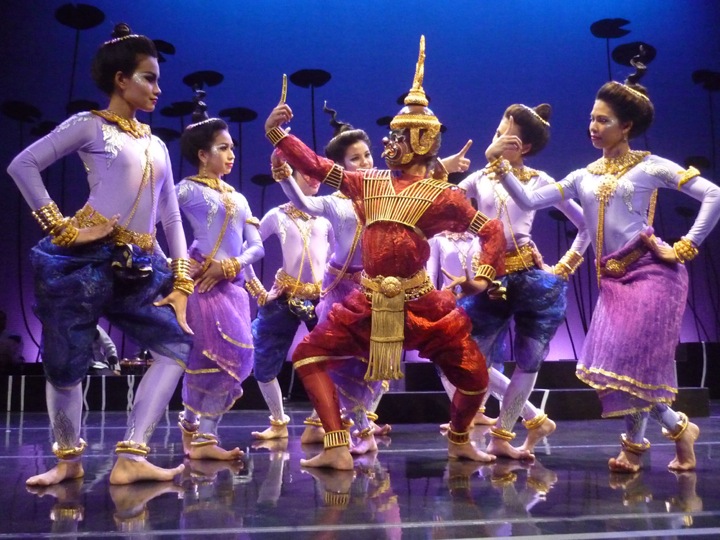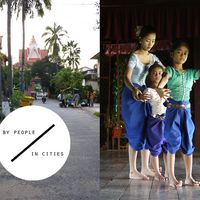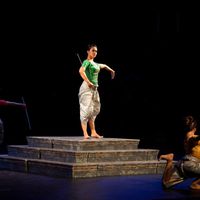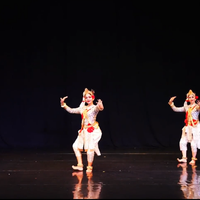At home and abroad | The Khmer Arts Ensemble
 culture360.org contributor Chum Chanveasna sat down with John Shapiro, Executive Director and Co-Founder of Khmer Arts, a Cambodian classical dance organization based in Takhmao, Cambodia, and overseas. She asks him some questions about the Khmer Arts Ensemble, the organization’s professional dance company, and its importance in the Cambodian arts scene.
culture360.org contributor Chum Chanveasna sat down with John Shapiro, Executive Director and Co-Founder of Khmer Arts, a Cambodian classical dance organization based in Takhmao, Cambodia, and overseas. She asks him some questions about the Khmer Arts Ensemble, the organization’s professional dance company, and its importance in the Cambodian arts scene. [caption id="attachment_18966" align="alignnone" width="576" caption="Sophiline Cheam Shapiro's “The Live of Giants”, performed by The Khmer Arts Ensemble, image courtesy of Chan Sopheap."]
Chum: The Khmer Arts Ensemble has a global reputation. Yet sometimes it seems as if the Ensemble is better known abroad than it is in Cambodia. Why is that?
Shapiro: In some ways it’s a matter of infrastructure. We have our own theater in Takhmao, about eleven kilometers from the Central Phnom Penh, but we have no funding to support a performance season. Because almost all public dance performances in Cambodia are free, including our own, we lose money and produce them infrequently. We’re looking for a way to make local performances sustainable. After all, this is our natural audience.
Chum: How can you make public performances sustainable?
Shapiro: You teach people that paying ten or five or three dollars for a ticket is a bargain. When they leave the theater, you want them thinking that that was the best purchase they ever made. But you have to introduce this idea strategically. One way is to focus on a special event, offering programming they’ve never seen before for a limited time. If you build up enough excitement about the festival and provide compelling performances, those who attend will spread the word and over time you’ll have a loyal paying audience.
Chum: Who is the target audience?
Shapiro: I think our target paying audience is made up of three main groups. The first is middle class Cambodians who are educated and employed—either before they start having children or after their children are grown. The second group is expatriates living in Phnom Penh. The third would be tourists, though we don’t expect this group to ever be a significant portion of our audience.
Chum: In Cambodia, many people think of tourists as golden deer. Why don’t you?
Shapiro: When I think of the relationship between tourism and dance, I think of Hawaii. Typically, tourists who vacation in Waikiki want to eat at a luau, drink a mai tai, wear a lei and see a dancer in a grass skirt perform hula. They couldn’t care less about the quality of the dance as long as they can take pictures and prove to their friends back home that they experienced Hawaii. Real hula is amazing, but I suspect very few tourists make an effort to find it. The same is true in Cambodia, where tourists want to have their picture taken next to a costumed dancer, no matter what her training or skill level. We’re a world-class professional dance company that performs compelling, original concert dances. If we went after the tourist market, we’d be competing with every third rate group in the country—and there are many of them. If tourists are only looking for cultural decoration, why would they pay more to see us?
http://www.youtube.com/watch?v=Y_-ClmczoG0
Chum: Do local audiences know the difference?
Shapiro: Absolutely. Local audiences tend to recognize a strong performance, even if they have little experience with classical dance. They also tell us how great it is to see something new. You have to keep in mind that almost every classical dance troupe, whether professional or amateur, in the whole country performs the same handful of dances, most of which were created in the 1950s and 1960s. Our artistic director, Sophiline Cheam Shapiro was the first, and pretty much remains the only, classical choreographer to make interpretive dances that respond to the contemporary world.
Chum: Do foreign audiences see the difference?
Shapiro: Presenters often don't. We met with a Japanese producer once who told us that because she couldn’t say our work was traditional and she couldn’t identify it as contemporary (in the Western sense), she had no idea how to sell us to theaters. It shouldn’t be that hard to understand. In an international tradition like ballet, every major company can perform 19th century story ballets, mid-20th century neo-classical ballets and contemporary ballets—often on the same program. Companies like Cedar Lake or Ballet Preljocaj specialize in contemporary work. Everyone gets it. So I’m a little baffled by the difficulty of understanding what neo-classical Cambodian dance is. Audiences all over the world respond well to our work once they see it. So the trick is getting the theaters interested in presenting us and getting bodies into the seats.
Chum: If Sophiline is the only one in Cambodia making dances in this way, do you have plans to encourage like-minded artists?
Shapiro: That brings us back to the festival. It’s a great way of showcasing a younger generation of artists, including the Ensemble members whom Sophiline has been training to choreograph. It develops domestic audiences as well as a body of work that can ultimately lead to a more extensive performance season.
Chanveasna Chum is company manager for the Khmer Arts Ensemble and will serve as festival manager for the 2012 Khmer Arts Festival. In 2010, she was an International Arts Management Fellow at the Kennedy Center for the Performing Arts in Washington, DC. She holds a BA from Phnom Penh’s National University of Management. Chanveasna Chum participated in the ASEF-supported Atelier for Young Festival Managers held in Singapore in May 2011.
Similar content
posted on
03 Oct 2018
16 Jan 2017
from - to
19 Jan 2013 - 28 Jan 2013
from - to
22 Nov 2021 - 26 Nov 2021






